
Phuket Islands South Andaman (Dive Site)


Phuket Diving area
Phi Phi Island is a group of six islands located 35km southeast of Phuket. The name "Phi Phi" is said to be derived from the way the islands appear to resemble the letter "P" when viewed from above. The main island, Phi Phi Don, is the larger of the two, while Phi Phi Leh is the smaller one. Situated midway between Phuket and Phi Phi Island, the area offers many fantastic diving spots, including the famous King Cruiser Wreck, a renowned wreck dive site in the Phuket area, as well as other sites like Koh Vida Nok and Pha Lhong Bay around Phi Phi Island.
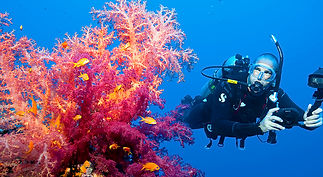

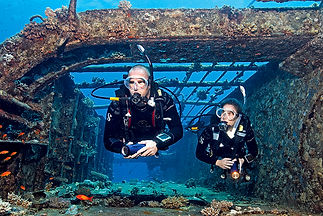
Anemone Reef
The submerged pinnacle rises about 5 meters above the water's surface. The anemones that cover its top like a carpet create one of the most beautiful and captivating underwater sights in the area. The site is home to a variety of marine life, including sea turtles, leopard sharks, seahorses, sea snakes, rare zebra moray eels, barracudas, trevallies, snappers, groupers, angelfish, butterflyfish, and scorpionfish, making it a rich and diverse underwater ecosystem.
Shark Point
Located near Anemone Reef and the King Cruiser Wreck, this dive site is named after the leopard sharks often seen on the sandy bottom. The area features several underwater pinnacles, with the northern pinnacle rising about 2 meters above the water. Soft corals, large fan corals, and hard coral gardens in deeper waters contribute to the site's rich marine ecosystem. Marine species found here include scorpionfish, stonefish, pufferfish, angelfish, snappers, groupers, and various types of moray eels. Among the rocks and corals, you can also spot colorful nudibranchs, shrimps, boxfish, sweetlips, and, on rare occasions, passing whale sharks.
King Cruiser Wreck
Located midway between Phuket and Phi Phi Island, King Cruiser is a popular wreck diving site in the Phuket area, known for the large passenger ship that sank here. The King Cruiser, a ferry imported from Japan, was 87 meters long and 25 meters wide. It sank on May 4, 1997, on top of the Aneh Mono Reef while heading to Phi Phi Island. A buoy marks the location on the water's surface.
The site is known for its strong currents, so divers must hold onto the descent line tied to the buoy to enter and exit the water safely. Over time, the shipwreck has become a thriving home for marine life. Soft corals cover the wreck, and various fish, sea snails, and small creatures have made it their habitat. There are several entry points to the hull, allowing divers to experience the thrill of wreck diving while exploring the inside of the ship.
4500 THB
Koh Racha Diving area (Dive Cove Company operates daily day trips)
About 20km south of Phuket, approximately a 2-hour boat ride, is Racha Island. The island consists of two areas:
the northern island, Racha Yai (which means "big"), and the southern island, Racha Noi (meaning "small"). The two islands are located about 45 minutes apart by boat.
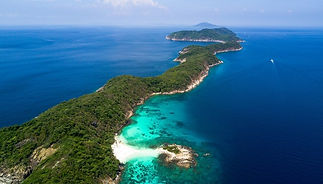
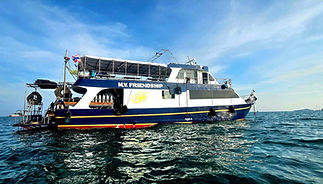
Racha Yai
Racha Yai is known for its crystal-clear water and white sandy beaches. The island features a bay on the east coast, which is an excellent diving spot during the rainy season. Visibility can reach up to 30 meters, with an average of 15-20 meters throughout the year. The dive site consists of a coral slope primarily made up of hard corals, along with a flat sandy bottom. Located inside the bay, this area is protected and free from strong currents, making it an ideal location for beginner divers. For more experienced divers, there are deeper coral reefs and wrecks to explore.
Racha Noi
Racha Noi, located a 45-minute boat ride south of Racha Yai, is renowned for its coral reefs that span the northern and southern ends of the island, along with an abundance of granite boulders. The site is famous for its excellent visibility, large granite boulders, and white sandy bottom. The main attractions here include impressive swim-throughs, crystal-clear waters, and stunning underwater scenery. The strong currents and deeper waters also provide opportunities to encounter large migratory species, such as manta rays, whale sharks, and spotted eagle rays.
4500 THB
Phi Phi Island Diving area


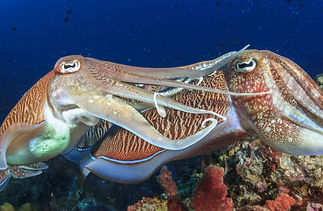
Hin Phae
Located about 200m west of Phi Phi Long Beach, this site features a beautiful coral reef on a sandy bottom. The maximum depth is around 12m, and it is a great spot to encounter many black-tip reef sharks.
Hin Dot = Chimney Rock
This site consists of three pinnacles resembling chimneys, ranging from 28m to 5m deep, situated on a sandy bottom and covered with both hard and soft corals. Schools of trevally and barracuda are commonly seen around the pinnacles, and leopard sharks are often spotted in the area.
Garang Heng = Hin Klai
Located just 2km east of Phi Phi Leh, this underwater reef is adorned with an abundance of anemones, hard corals, jar corals, and giant fan corals. Marine life here includes leopard sharks, blue-spotted stingrays, sea turtles, ghost pipefish, and nudibranchs.
Koh Vida Nai = Inner Father
This dive site features an interesting swim-through with large rocks, surrounded by schools of glassfish. Shallow coral gardens are home to ghost pipefish, boxer shrimp, seahorses, and numerous nudibranchs. Black-tip sharks and leopard sharks are also commonly spotted here.
Koh Vida Nok
This dive site is a typical wall dive located near Phi Phi Island, showcasing large hard corals like fan corals and vibrant soft coral colonies. It is frequented by large schools of yellow snappers and barracudas. Occasionally, hawksbill turtles and black-tip sharks can be spotted. With some luck, divers may also encounter leopard sharks in the deeper sandy areas.
4500 THB
Koh Haa Diving area
Koh Haa, which means "five islands" in Thai, includes Koh Haa Yai as the largest of the group. The island features small sandy beaches and shallow bays. Koh Haa Neua and Koh Haa Yai are particularly famous for their stunning cave formations in the South Andaman Sea, with three caves of varying sizes and a small Doom. Wall diving is also available around these caves, offering an exciting underwater exploration experience.
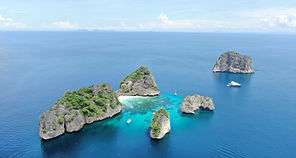
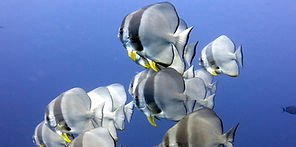


Koh Haa Neua (No.1)
Koh Ha Nua, the northernmost island in the Koh Ha Archipelago, is known for its remarkable underwater features. The name "Neua" means "north" in Thai. A famous attraction on the island is the Chimney cave, located in the southern part of the island. This vertical cave has an entrance at a depth of 16m, with two exits at depths of 5m and 7m. Despite its small size, the light streaming in from above creates a beautiful ambiance, and it's a unique experience to see the silhouette of a school of sweepers (spatula fish) merging with the sunlight. The island offers numerous swim-throughs, allowing divers to enjoy the scenic beauty of corals and marine life in the crevices.
Koh Haa 2 & 4 (No.2 & No.4)
The slopes of Islands 2 and 4 in the Koh Ha Archipelago are abundant with coral reefs and sandy gravel areas. These areas are often frequented by fusiliers, snappers, and large predators like trevallies and barracudas, hunting on the reefs. The shallow regions of Island 2, particularly the inner lagoon, feature beautiful hard coral and soft coral gardens. Additionally, the sand and debris areas are teeming with a variety of small marine creatures, making it a fascinating site for divers and underwater enthusiasts.
Koh Haa Sam (No.3)
Located on Koharagun Island No. 3, this site is an excellent spot for night diving. The bay-shaped terrain ensures minimal currents and waves, creating a calm and peaceful environment. The gentle sandy slope is home to many small creatures, including various crustaceans, making it an ideal location for those seeking to observe the fascinating nocturnal marine life.
Koh Haa Yai (No.5)
Among the five islands of the Koha Archipelago, Kohaya is the largest and is surrounded by both hard and soft corals. The area is home to a wide variety of corals, including fan corals, shoal corals, and hard corals. It's also a great spot for spotting nudibranchs. One of the main attractions on Kohaya is a large cave called the Twin Cathedral. The cave has two entrances, but they are connected by a hole in the middle, making it feel like one large cave. The ceiling of the cave is about 2-3 meters higher than the water level, forming an air pocket. Additionally, there is another narrow cave next to the main one, giving the entire structure the feeling of being three separate caves.
5600 THB
Hin Daeng & Hin Muang Diving area
Hin Daeng/Hin Muang, located 60km south of Phuket, consists of two distinct features. Hin Daeng is a long rocky mountain range, situated just a few hundred meters from Hin Muang. The top of Hin Daeng reaches a depth of 8-9 meters, with the bottom extending down to 60-70 meters. Hin Daeng features three small rocky peaks above the water's surface. On the other hand, Hin Muang is a submerged pinnacle, adding to the site's allure for divers.


Hin Daeng
In Thai, "Hin" means rock, and "Daeng" means red, so the name Hin Daeng refers to the red rocks in the area. As the name suggests, the rocks are abundant with red coral. Beneath the rock, there is a considerable underwater reef, which is slightly visible above the water's surface, and a channel runs through the middle of the island. You can also encounter schools of yellow snappers, rainbow runners, and fusiliers. If you're lucky, you may even spot manta rays.
Hin Muang
In Thai, "Muang" means purple, and as the name suggests, the rocks are covered with purple corals. The underwater terrain of Hin Muang is similar to Hin Daeng but is deeper and more stretched out, with stronger currents. It also features small channels. You can observe many yellowmouth snappers, fusiliers, and red-tooth triggers. If you're fortunate, you might even spot manta rays or whale sharks.
5600 THB
Dive sites in the Central Andaman Sea

WHY SHOULD I BOOK WITH DIVE COVE ?
A Real Dive Center With A Real Shop
-
Dive Cove isn’t just a website. We’re a fully-equipped PADI CDC Center with experienced staff, top-quality rental gear, and deep local knowledge. We’re ready to assist you in person!
-
22 Years of Thailand Diving Experience
-
With over 22 years of diving experience in Phuket, we’ve logged thousands of dives across the region. We know the dive sites, the boats, and the best spots. Trust us to find your ideal dive trip!
-
Liveaboard Price Guarantee
-
We offer official rates agreed with boat operators. If you find the same trip for less, tell us! We guarantee the best price for your liveaboard trip—no exceptions!
-
We Make Booking Liveaboards Easy
-
Booking with Dive Cove is fast and simple. Have questions? We’ve got the answers! Need assistance? Call us! We offer hassle-free online payments with no fees for most trips. We know the boats and the area inside and out!
WE HIGHLY RECOMMEND
AQUA LIVEABOARDS!

